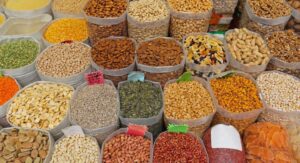Primary And Secondary Products SS2 Marketing Lesson Note
Download Lesson NoteTopic: Primary And Secondary Products

A product is an item offered for sale. A product can be a service or an item. It can be physical virtual or cyber form. Every product is made at a cost and each is sold at a price. The price that can be charged depends on the market, the quality, the marketing and the segment that is targeted.
PRIMARY PRODUCTS
Primary products are goods that are available for use by the final consumer. These goods have not undergone any form of processing.
Examples Of Primary Products
- Yam tubers
- Cotton
- Corn
- Fresh tomatoes
- Fresh potatoes etc.
Structure For The Sales And Marketing Of Primary Products
The type of goods determines to a large extent the appropriate channels for the marketing and sales of primary goods. Here are a few structures that facilitate the sales and marketing of primary goods
- Agents: It consists of the complete organization of the manufacturer, wholesaler, retailer and consumer.
- Marketing Agencies: These are institutions that take up the role of promoting the goods via appropriate mediums for massive sales and patronage by the consumers.
- Intermediaries: This is the use of in-between channels by the manufacturers for the onward distribution of their goods.
SECONDARY PRODUCTS
These refer to goods that have undergone processing.
Examples Of Secondary Products
- Textiles
- Shoes
- Sugar
- Bread
- Books
- Caps
- vii. Calculators etc
Structure For The Sales And Marketing Of Secondary Products
- Direct Selling: this is the marketing and selling of products directly to the consumers away from a fixed retail location. Peddling is the oldest form of direct selling.
- Selling Through Intermediaries: This is when intermediaries such as wholesalers and retailers are used for the sales of the products.
- Dual distribution: This is when more than one channel is used for the distribution of the products. They may sell directly to end-users and also sell through intermediaries.
- Reverse channels: This is when the products move in a reverse flow: from the consumer to the intermediary to the beneficiary.
MARKET UNION INVOLVEMENT
A market union is an association of traders of a particular commodity who come together to promote their objective. Market unions perform two functions:
- Social Function: they render financial help to members in times of lack and during important occasions.
- Political Function: they lobby the authorities to ensure adequate supply, maintenance and provision of facilities at the traditional open market. They also regulate and restrict entry into their type of trade
Importance Of Market Unions
- They fight for the rights of the members and the group.
- They demand the quality production of goods.
- They protest against unfavourable government policies.
- They discipline erring members for violation of policies and regulations.
- They enlighten the public on matters of common interest especially on new laws regarding their industry.
- They perform other legitimate and civilized functions.
- They organize product exhibitions, workshops and symposiums for public knowledge and enlightenment.
Merits Of Market Union Involvement In The Local Markets
- They generate more sales in their industry.
- They set a strong standard as a measure of control of quality in the market.
- They fight for the injection of money into the market.
- They serve as financial aid to the traders.
- They are in charge of price control.
Problems Of Market Unions’ Involvement In The Local Markets
- They are usually found only in large markets hence the poor attitudes of traders in small markets where such unions do not exist.
- They are too many and often in small sizes thereby reducing the effects of their activities
- Those with a small number of participants do not have access to funding.
- Poor leadership as most market union executives put their personal goals and interests above the entire group.
- High level of corruption especially in the leadership.
- Rivalry and conflicts among warring factions thereby reducing the credibility of the group.





















